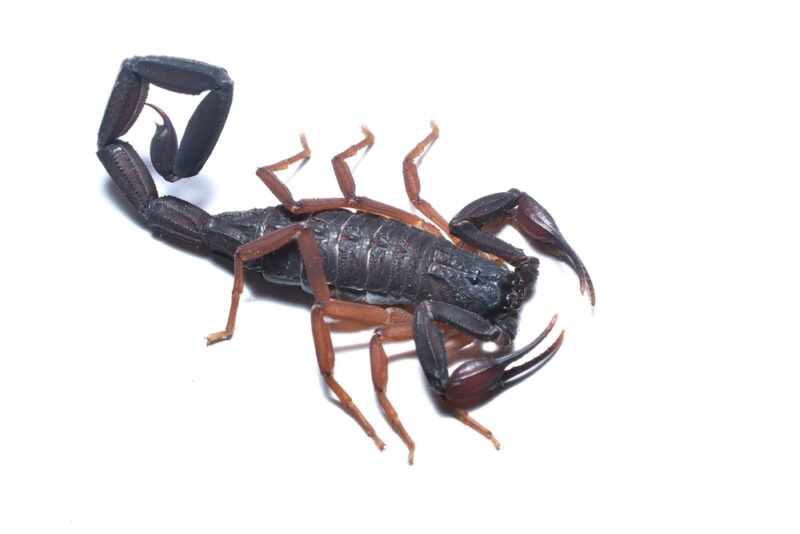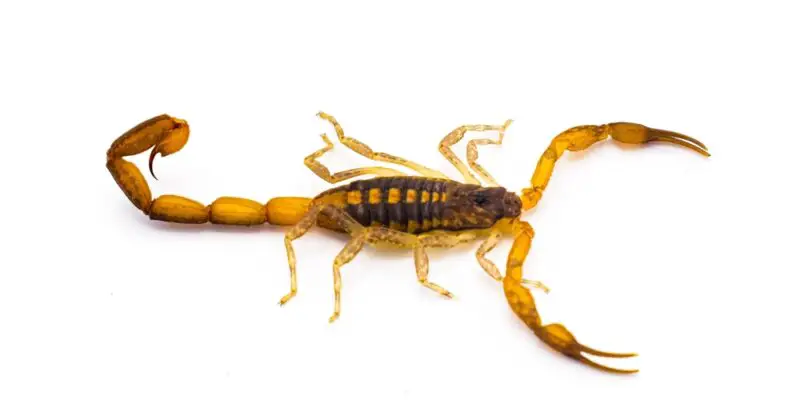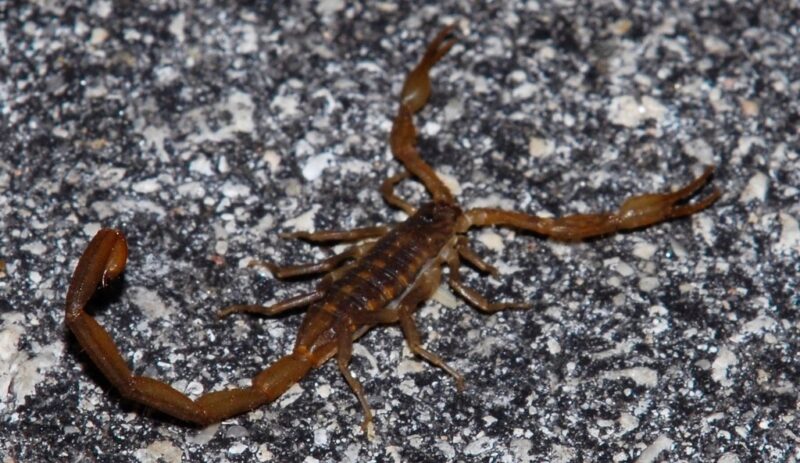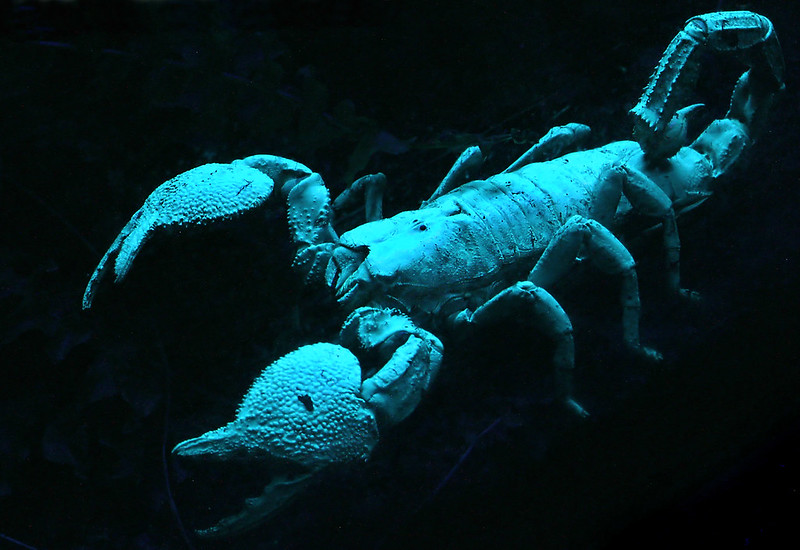The state of Florida is home to the following 3 species of scorpions:
- Florida Bark Scorpion
- Hentz Striped Scorpion
- Guiana Striped Scorpion
These three scorpions are all members of the Buthidae family.
For a general description, scorpions are arachnids, just as spiders are. In appearance, scorpions look a little bit like tiny land-dwelling lobsters with some distinctions. Lobsters have 10 legs, while scorpions have 8, and of course, lobsters don’t have a bulbous venomous stinger on the tip of their tail, while scorpions do.
The good news is none of the 3 Florida scorpions packs a fatal sting. In fact, they are no more medically significant than a wasp sting.
That is unless you have an allergic reaction. In rare cases, scorpion venom has the potential to cause a severe allergic reaction. As of 2021, there were 4 deaths caused by scorpion stings in the previous 11 years. See
Serious symptoms such as anaphylactic shock are a possibility. If you have blurred vision, muscle twitching, intense pain, or difficulty breathing after experiencing a scorpion sting, seek immediate medical help.

Florida Bark Scorpion (Centruroides gracilis)
The first scorpion species we’ll talk about is the Florida Bark Scorpion. This scorpion also goes by the common names Slender Brown Scorpion and Brown Bark Scorpion.
This Scorpion is actually not native to the United States but is classed as an invasive species. The most likely way that it arrived here from the tropics is by hitching rides on boats. See
Florida Bark Scorpions are a native species in tropical parts of the world, such as Mexico, Honduras, Belize, and Honduras. It is an introduced species in the United States, Cuba, Panama, Columbia, Ecuador, Jamaica, in the western hemisphere. What’s more, in Africa, it has accidentally been introduced to Cameroon, Gabon, and the Canary Islands See
What do Florida Bark Scorpions Look Like?
Male Florida Bark Scorpions measure 1.97 to 6 inches (50-153mm), while female Florida Bark Scorpions measure 2.36 to 3.94 inches (60 to 100mm) See Also See
Florida Bark scorpions are variable in color. They may be reddish brown or black with reddish pincers. They are also sometimes dark brown with yellowish legs, reddish pincers, and black tail sections.
Are Florida Bark Scorpions Dangerous
Although they are Buthid scorpions, their venom is not considered to be dangerous. Consequently, the research into this species up to now has been minimal. See
Like all scorpions, Florida Bark Scorpions are nocturnal creatures. They come out to hunt at night. During the day, they hide out in dark places such as leaf litter, under tree bark, under loose rocks, or in manmade structures such as attics, crawl spaces, or wood piles.
What do Florida Bark Scorpions eat?
Florida Bark Scorpions prey on other arthropods such as insects and arachnids like spiders and other scorpions.
What eats Florida Bark Scorpions?
First of all, other Florida Bark Scorpions. All Scorpions are cannibalistic.
Scorpions in Florida are also preyed upon by tarantulas such as the Mexican Red Rump Tarantula (Tliltocatl vagans). This tarantula is actually an invasive species in Florida. It is native to Mexico. It will prey on anything it can overpower, including insects, scorpions, lizards, and even small rodents. See
Other scorpion predators in Florida include birds, snakes, and lizards.

Hentz Striped Scorpion (Centruroides hentzi)
Hentz striped scorpions are the most common scorpions in Florida. They live in nearly every part of the state.
These scorpions are most commonly found beneath stones and forest litter on the ground during the day. They also take advantage of manmade structures like wall voids and crawl spaces to use as hiding places.
What do Hentz Striped Scorpions look like?
First of all, Hentz Striped Scorpions are also the smallest of the three scorpions. Adult Hentz Striped Scorpions typically range from 2 to 3 inches (50.8 to 76.2 mm) in length.
In color, Hentz Striped Scorpions are tan to dark brown with yellow-green stripes on their abdomen, which is proportionately slender.
Another distinction that Hentz Striped Scorpions have is that they have a tooth behind the bulb of their stingers.
What do Hentz Striped Scorpions eat?
These scorpions dine on other scorpions, small insects, and spiders. They are beneficial to humanity in that they eat cockroaches. See

Guiana Striped Scorpion (Centruroides guanensis)
The Guiana Striped Scorpion also goes by the common name Keys Bark Scorpion. These are the rarest of the three types of scorpions found in Florida. They exist in south Florida in Collier, Miami-Dade, and Monroe counties, including the Florida Keys. They also inhabit the Bahamas and Cuba in the Caribbean.
What do Guiana Striped Scorpions look like?
Adult Guiana Striped Scorpions range in size from 1.37 to 2.36 inches (35 to 60mm) for females and 1.57 2.75 inches (40 to 70mm) for males, respectively.
Guiana Scorpions are yellow with a faint dusky discoloration over the entirety of their body, with the exception of two dark longitudinal bands along their back. In the majority of specimens, there is a thin black line running between the two bands. Their pincers, legs, and mouthparts are spotted.
The dusky pattern may be absent in some populations. See
Are Guiana Scorpions dangerous?
The venom of this scorpion is mild. However, they do pack a painful sting. The aftereffects of which can last for 1 to 5 hours.
Scorpion Life Cycle
The mating behavior of most scorpion species is quite similar, so this section will suffice for all three of Florida’s scorpion species.
Scorpions mate in the fall and also occasionally in spring or early summer. The mating process begins with the male engaging the female scorpion in an elaborate mating dance called the promenade a deux. At this time, the male maneuvers the female to a spot where he can deposit a sperm packet called a spermatophore for her reception.
The male must hold the female over the spermatophore long enough for her to receive it. Therefore, larger males successfully mate a larger percentage of the time. If the female accepts the male’s spermatophore, the pair join together and rub chelicera in the “kiss” stage. At this point, the female takes up the spermatophore.
What follows is about an 8-month gestation, after which their offspring are born alive.
After the newborn scorpions free themselves from the birth membrane, they will climb up their mother’s walking legs and onto her back. The young scorpions ride there on their mother’s back in a grouped formation, only climbing down to feed on pellets that the female scorpions create for them when she feeds until they are sufficiently old to strike out on their own. This is generally after their first molt. See
Most female scorpions in Florida reach maturity at a little under a year of age, while most males mature at around 280 days.
Most Florida scorpions live to be around 3 years of age in the wild.

How to look for Scorpions
As stated above, scorpions are nocturnal creatures. During the day, they hide out. Crawl spaces, wood stacks, rocky hillsides, and leaf-covered areas are all examples of likely hiding spots.
The best way to detect the presence of scorpions, though, is to search for them after dark.
Scorpions have compounds in their exoskeletons that glow under black light. To see them after dark, in your yard, or if you are camping in an area where scorpions are active, the best way to find them is with a UV flashlight. Use the ultraviolet light to scan your yard or campsite after dark. The scorpions will glow a bright blueish color.
Remember that the darker the night, the more the scorpion will glow. In other words, they are more luminous on a night of a new moon, for example. What’s more, campfires and other sources of light will cut down on the effectiveness of your ultraviolet light source.
One last thing to remember on this subject is that UV light radiating in the 320 to 400 nm range isn’t overly harmful to your vision. However, if you choose to use a UV light source that produces shorter wavelengths, you’ll want to also use eye protection.
Fun Fact
Even fossilized scorpions glow under ultraviolet light.
Treatment for scorpion stings
- Clean the sting site with mild soap and water.
- Apply an ice pack to the site of the sting.
- Avoid eating or drinking if you are having trouble swallowing.
- Treat with an over-the-counter pain reliever as needed.
- Make sure that the affected individual’s Tetanus vaccination is up to date.
- If any of the severe symptoms described in the above paragraphs are manifest, seek immediate medical attention. See
Recent Posts
The only venomous snakes in Washington State are Northern Pacific Rattlesnakes. The Northern Pacific Rattlesnake (Crotalus oreganus oreganus) is a sub-species of the Western Rattlesnake. Anyone...
Skunks are not classified as true hibernators. But they go into a state of torpor when the weather gets cold. Skunks are light sleep hibernators, along with opossums, bears, and raccoons. ...
